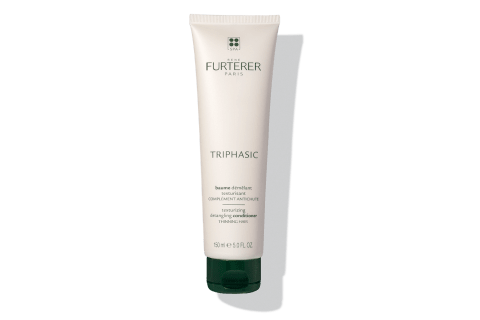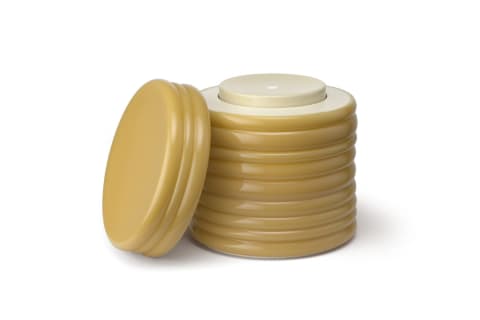
Our editors have independently chosen the products listed on this page. If you purchase something mentioned in this article, we may earn a small commission.
Hair loss is a very complex issue, which means it may require multiple remedies to revive a lush, full mane, like regular scalp massages, supplements, and hair growth serums, among others. For some, though, the shedding is simply nonreversible (for a variety of reasons). In those cases, many find success with cosmetic hair restoration treatments—like scalp tattoos.
Before you ask: Yes, these tattoos look incredibly natural. It’s actually a super-detailed process called scalp micropigmentation, and it camouflages thinning hair in a very precise way. If you’re at all curious about this inking method and how it works, check out our expert-led guide below.
What is scalp micropigmentation?
Scalp micropigmentation (SMP) is a permanent cosmetic procedure that uses a pen-style tattoo machine to implant microdots on the scalp. “The technique mimics the look of hair follicles to create the look of realistic hair on both completely bald scalps and thinning hair,” says Gisele Jara, scalp micropigmentation artist at Studio Sashiko.
You might think it sounds similar to eyebrow microblading (another permanent tattoo procedure), but they actually require very different tools, pigments, and techniques. See, microblading uses full strokes to mimic the actual wisps of hair, whereas SMP places the ink in teeny dots to create shadow—which creates a softer, more natural-looking effect. Those dots also penetrate more deeply into the skin (as opposed to microblading, which creates shallow strokes), which provides a longer-term or permanent result, says certified trichologist William Gaunitz, FWTS, founder of Advanced Trichology.
Additionally, the SMP pigment is meant to match your hair follicle shade, not the strands themselves. “Everyone, regardless of hair color, has a follicle that is a shade of black unique to them,” says Jara. “At times, neutralizer colors can be used to mix into the black pigment, if the client’s skin undertone calls for it.”
Short answer? Anyone dealing with hair loss concerns is a great candidate. SMP can fill in a receding hairline, cover patches of alopecia areata, or even chemotherapy-related hair loss, notes Gaunitz. “It can even be used to cover the scar area from other procedures,” he adds, since hair cannot naturally grow over destroyed follicles.
In terms of placement, it doesn’t really matter where you’re experiencing hair loss—SMP can add density to the hairline, temples, crown, etc. Just know that this procedure does not create actual wisps of hair—again, these are tiny microdots that create a shadowed, almost powdery effect.
That said: “Not everyone will look good with a hair density treatment,” says Jara. It might blend more seamlessly with your natural lengths around the hairline or temples, where you do have natural shadows; but if you’re hoping to cover a larger surface area or your whole head, it will resemble more of a buzzed cut. “Depending on the pattern of hair loss, a complete shave may be needed for SMP to look natural,” Jara adds.
First things first: You and your artist will come up with a detailed treatment plan during an in-depth consultation, where you’ll decide on the exact pigment and needle size necessary. (Yes, there are different needle options; everyone’s follicles are not the same size!) If you’re hoping to tattoo the hairline, the artist will also discuss options that best suit your face shape.
After landing on a plan of action, it’s time to tattoo: Your artist will take the penlike machine and get to work, entering the dermis at about 2 millimeters deep, depending on your individual scalp thickness. “There definitely is a sweet spot involved with SMP, which is why it’s important to pick a well-trained artist!” Jara says. “If the needle only hits the epidermis layer, the pigment will fade quickly and come off through the layer’s natural process of shedding and renewal. If the needle goes too deep, beyond the epidermis into the subcutaneous layer, that’s when pigment migrates and stains the scalp in big round blotches.”
If this is your first session, your artist will typically use the lightest hue in your chosen shade range and tattoo the microdots with plenty of space in between—that way, they can lay the foundation and understand how your scalp heals before using more precise techniques. During the second session, your artist will fill in those gaps with more micro-impressions and assess whether they need to use a slightly darker or lighter shade. “The third session is usually when all the little details are finely tuned,” Jara notes. Your artist will add even more density and perhaps go darker, depending on how you’ve healed. Typically, you’ll need two to three sessions to reach final results (four, for some), so patience is key.
Each session can take anywhere from one to five hours, says Jara, depending on the size of the area. After the first round, you’ll schedule the next session 10 to 14 days out and focus on healing and aftercare (more on that in a moment). “It is very important for the scalp to be fully healed before implanting further impressions into the scalp,” Jara adds. “This will prevent ink migration and oversaturation.”
You’re probably thinking: OK, sounds wonderful, but how badly does it hurt? Well, it’s definitely not a soothing sensation—if you’ve ever gotten a tattoo, you’re likely familiar with some stinging as the artist outlines your design. It might be uncomfortable, and you may experience redness, but SMP shouldn’t be excessively painful. “I have never had to use numbing cream for a client but will do so to attend to a client’s comfort level,” Jara notes.
You also may be concerned about potentially destroying your existing hair follicles with the tattoo. But rest assured, “scalp micropigmentation does not damage or impair existing hair follicles in any way,” says Gaunitz. Think about a tattoo you may have on any other part of your body—hair still grows in that area, yes? So don’t worry about getting SMP on areas of your scalp that might grow back.
However, “At the end of the day, SMP is a type of restorative tattoo and must be treated with care like a regular tattoo,” says Jara. “All tattoos have a risk of infection if not cared for properly.” All that to say: Do not skimp on aftercare.
Each artist may have slightly different prep instructions, but it’s important to follow them to a T so you can provide a healthy, supple canvas.
“My prep involves doing a sugar scrub a couple of days before the appointment, moisturizing the scalp, removing hair units, discontinuing the use of topical hair products (medicated and nonmedicated), avoiding a sunburn, and avoiding caffeine and alcohol the day before and day of your appointment,” says Jara. Gaunitz seconds the caffeine and alcohol warning, as they can thin the blood, which can lead to increased bleeding during the tattoo procedure.
postbiotic body lotion
Ultra-hydrating formula that nourishes your skin barrier, available in unscented and neroli
-v1646695196476.jpg?1148x800)
As for aftercare, you’ll want to keep the area as dry as possible during the first week or so (again, healing typically takes 10 to 14 days per session). “This may be difficult during showers, but as long as you try to avoid it as much as possible and tap dry with a towel afterward, it will be fine,” Jara says. Just don’t submerge your head entirely into water—no lakes, pools, baths, etc. You’ll also want to avoid excessive sweat as much as you can, like from intense exercise or saunas.
Depending on when you start scabbing (which is totally natural!), you can start using a light layer of moisturizer on the area twice a day. “Any fragrance-free light moisturizer would work,” says Jara, just make sure it’s super gentle and nourishing (i.e., no exfoliants or heavy-duty actives). See here for our favorite fragrance-free lotions to buy post-ink.
Finally, protect the area from direct sun exposure: You might want to invest in a scalp sunscreen to shield the area, especially post-treatment when the skin is particularly vulnerable.
SMP is a permanent cosmetic procedure, so you can expect the pigment to stick around, you know, permanently. However, like other tattoos, the pigment can start to fade over time without touch-ups. “Results can last between four to eight years with touch-ups every few years,” notes Jara, assuming you’re diligent with aftercare.
SMP is not a hair loss treatment per se (it doesn’t regrow hair), but for those hoping to camouflage thinning areas or fill out a receding hairline, it may be worth looking into. If you’re not ready to jump into cosmetic procedures quite yet, not to worry—there are plenty of hair growth treatments and products for you to try. Here’s a list of our favorites to make the search easier.
-v1646695196476.jpg?1148x800)
postbiotic body lotion
Ultra-hydrating formula that nourishes your skin barrier, available in unscented and neroli
postbiotic body lotion
Ultra-hydrating formula that nourishes your skin barrier, available in unscented and neroli
-v1646695196476.jpg?1148x800)
https://www.mindbodygreen.com/articles/scalp-micropigmentation








